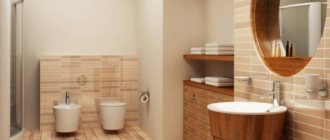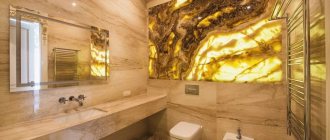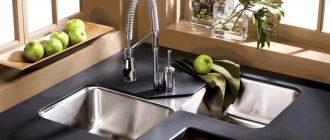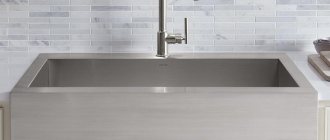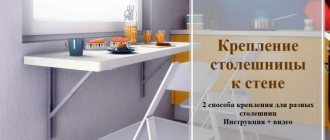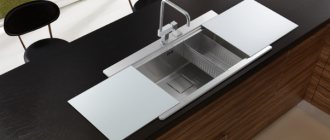Welded washing bathtubs are used in public catering establishments and are intended for washing kitchen utensils and utensils, defrosting food products, etc. The washing tank of the bathtub is made of AISI 430 stainless steel, welds and edges are thoroughly cleaned and specially processed. The frame of the washing bathtubs is made collapsible for ease of transportation; the legs are equipped with height-adjustable supports.
Stainless steel kitchen sink: advantages of use
Stainless steel kitchen sinks are used in most homes. Among the reasons that determined the choice of this particular option from among those offered by sink manufacturers, we will highlight the most significant:
- durability at a relatively low cost;
- ease of installation, combined with the ability to fit the product into almost any interior style;
Stainless steel kitchen sink with glossy surface
- availability of a wide range;
- compliance with hygienic requirements. The material does not contribute to the concentration of microorganisms;
- ease of maintenance.
- no damage will be caused by aggressive substances and corrosion;
- due to the elasticity, plasticity and strength of the material, mechanical damage from accidentally falling objects is excluded;
- the ability of steel to withstand heating up to 1450ºС allows you not to be afraid of damage caused by the action of boiling water or heated dishes;
- exposure to temperature changes does not pose a threat to the material of the product;
- The environmentally friendly design is easily disposed of and can be sent for recycling.
Note! The matte surface of some sink models is not only a design solution, but also additional protection from mechanical damage.
A stainless steel kitchen sink, which most consumers prefer to buy, also has its disadvantages. These include:
- desirability of grounding. In a modern kitchen there will always be household electrical appliances. Therefore, you should be concerned about safety measures when dealing with material with high electrical conductivity;
- the appearance of lime deposits is inevitable. It’s easy to get rid of salt deposits by wiping the surface dry after each use;
- Water beating against a sink makes a lot of noise, especially when the thickness of the steel sheet is small. Well-known manufacturers produce low-noise products using thick walls and installing rubber or plastic pads on the back of the structure;
- Thin-walled products are also characterized by oscillation of the mixer, which moves when the pressure changes because the steel sheet bends.
A sink made of thick steel sheet does not make noise when water gets into it
It is also possible to cope with the noise on your own. It is enough to apply a layer of ordinary polyurethane foam to the back of the sink bottom and let it dry for 24 hours.
Note! It is best to choose a sink with a remote control drain, so you don't have to put your hands in dirty water to remove the stopper.
Damage in the form of deflection of the steel surface can occur when a heavy, pointed object falls. True, this scenario seems extremely unlikely.
Features of the production technology of metal sinks for the kitchen and their types
A stainless steel sink can be made using one of two methods: welding or stamping. When deciding which kitchen sink to choose, this aspect is also of some importance.
The manufacture of welded sinks involves the connection of several parts. The bowl and base are connected using welds. The most problematic part of such a design is the welded seams, where, if the quality of workmanship is poor, leaks may begin over time. The cost of welded sinks is much higher than stamped ones. The explanation lies in the advantages of using welding capabilities, which are much greater than when stamping:
- element-by-element manufacturing allows for greater flexibility in modeling during manufacturing and significantly improves the quality of both individual parts and the design as a whole;
- the use of thicker steel sheets makes the structure more durable, reliable and less noisy;
- In terms of depth, shape and dimensions, and finishing, the range of welded products is very diverse.
Kitchen sink, complete with storage compartment for small items and waste container
Polishing the seams makes them completely invisible. An undermount sink of considerable depth for a large kitchen set, which can also be used in a catering establishment, is made exclusively by welding.
Stamped sinks, devoid of welded seams, have a place in the kitchen where the product is not expected to be used under intense conditions. Stamped structures are made using special machines. The use of a single sheet of steel in a simplified technological process has a positive effect on cost. The disadvantages of the stamping method include the possibility of unequal surface thickness if the execution technology is violated. In addition, it will not be possible to obtain a product of sufficiently large dimensions and depth due to the limitations arising from the use of a standard steel sheet.
For a long time, the depth of the bowl when making sinks using the stamping method did not exceed 150 mm. Now a number of manufacturers have managed to overcome this disadvantage, increasing the competitiveness of their own products.
Compact kitchen sink with additional drainer
Where to install an overhead and built-in sink in a kitchen countertop
One of the important circumstances influencing the choice of sink is the way in which it is planned to be installed.
Based on the installation method, kitchen sinks are:
- built-in or integrated;
- invoices;
- mortise.
Kitchens for Khrushchev houses with a sink in the corner are equipped with overhead sinks.
Note! Cheap overhead sinks do not come with mounting hardware and must be purchased separately. If you do not use the clamps, the sink will move during use.
The overhead sink is easy to install. It is placed on a floor stand, replacing a tabletop. An important advantage of this design, in addition to the basic ease of installation and low cost, is the thickness of the steel sheet - at least 1.0 mm. Connecting to the water supply is accompanied by the usual drawback for such structures - moisture getting on the cabinet. Furniture can deteriorate quite quickly if you do not take care of the condition of the cracks.
Stainless Steel Undermount Kitchen Sink
Integrated sinks are kitchen sinks that are built into the countertop. The type of countertop does not matter, but installation is fraught with difficulties, in particular with the routing. The bowl is usually lowered below the tabletop. The structure built into kitchen furniture is quite expensive, but it makes up for it with its original appearance. They combine an integrated sink, as usual, with a countertop made from natural or artificial stone.
What are the features of mortise kitchen sinks?
Most often, a mortise sink is installed in kitchens. The versatility of this type of design allows:
- install it exactly like an overhead sink;
- place on top of the countertop. Only mortise models can be used if there is a chipboard tabletop. A protective barrier will be installed along the sides of the sink to protect the base of the furniture from moisture;
- a kitchen sink built under the countertop is another option, more expensive. Undercounter kitchen sinks go well with stone (natural or artificial) materials.
Installing a built-in stainless steel sink into a countertop
Installing a sink into a countertop in a kitchen or placing a kitchen sink under a countertop is much more difficult than simply laying a sink on top of a floor cabinet. Therefore, the cost of mortise models of this type is much higher.
This design is inserted into an opening cut using a specific template. The package includes special fastenings. After completing the installation, you will need to seal the joint between the side of the sink and the countertop to prevent moisture from entering and damaging the furniture.
Most buyers purchase a built-in stainless steel sink due to its convenience, hygiene and relatively low cost.
A built-in sink looks stylish on any surface and in any interior.
On a note ! Built-in sinks are suitable for installation in countertops made of any material, including artificial and natural stone.
Features of under-countertop sinks
Manufacturers of modern kitchen sinks demonstrate the richness of the design of their products and the use of a wide variety of materials for their manufacture. Everyone has the opportunity to buy a built-in kitchen sink that suits their idea of the kitchen interior.
Multifunctionality and ease of use
All modern built-in kitchen sinks have such properties as versatility and comfortable use in everyday life. At the discretion of the owners, a suitable sink design option can be selected:
- Classic sink with one bowl of any shape.
- Sink with two bowls. Convenience lies in the fact that in one bowl you can wash, for example, vegetables and fruits, and the other bowl will be reserved for washing dishes.
- Sink with one wing or with several wings. The wings create additional convenience for placing washed dishes, detergents or other things.
You can place the sink where it will be convenient to use it. Sometimes kitchen furniture is selected in such a way that the sink is located in it in the most efficient way. This can be a corner option, with an L-shaped arrangement of furniture. Or the sink can be a continuation of the work area on the same level as the stove. Or you can place it separately against the wall. The island version with the sink located in the middle of the room looks very original. In any case, the variety of designs, shapes and sizes makes it possible to choose the right sink for absolutely any kitchen.
There are three design options for sinks, differing in the type of installation:
- Mortise. This is the most common and inexpensive type of kitchen sink. The product is installed by inserting into kitchen furniture. In other words, the sink is mounted in a hole specially cut for this purpose in the countertop.
- Invoice. This design is simply placed on top of a kitchen cabinet that does not have a top. It replaces the tabletop.
- Integrated. Used for installation on granite or stone countertops and is integral with the countertop. The sink can be located at the same level as the countertop, or be lower or higher than the countertop level. This type of sink requires installation using professional equipment. In some cases, integrated sinks are supplied complete with kitchen furniture.
Modern built-in kitchen sink
The following materials are used to make sinks:
- Stainless steel. This is the most popular option. The surface can be polished, mirror, matte, or have a relief coating. It is more practical to use sinks with a relief coating, since scratches and water drops are not visible on their surface. Built-in stainless steel sinks are distinguished by their affordable price, environmental friendliness, resistance to temperature changes and beautiful appearance. Stainless steel is easy to wash and clean.
- Ceramics. Such sinks are impact-resistant and beautiful, their surfaces are resistant to abrasives, dyes and acids.
- Granite, artificial stone. Granite sinks are made from granite chips, quartz sand and acrylic. Built-in sinks made of artificial stone are safe for health, perfectly absorb the noise of flowing water, are impact-resistant, scratch-resistant, and look presentable.
Other materials such as copper, marble and acrylic are not as popular for making sinks.
Durability and reliability
Whatever material is used to make the sink, we can confidently declare its high reliability. Both ceramics, granite, and stainless steel are resistant not only to mechanical stress, but also to acids, caustic substances, and dyes. They are able to withstand very high temperatures without deformation or cracking. It is believed that granite sinks are the most durable. With proper and careful care, it can last more than 50 years. Built-in sinks can also be used for installation in the bathroom.
Stainless steel does not last that long, but its strength usually lasts for 20 years. It is not recommended to purchase sinks from unknown manufacturers that may have been manufactured with violations of technology. Even if their price is low. Typically, such manufacturers tend to save material, which can affect the service life of the products.
Dimensions of built-in sinks
Depending on the characteristics of the furniture and its location, you can choose the appropriate shape and size of the sink. The variety of sizes and geometric shapes of these products is simply amazing. The shape of sinks can be square, rectangular, oval, round, trapezoidal, corner. They can have a completely unique shape, ready-made or custom-made.
The same applies to sizes. Select the appropriate size of the sink according to the size of the kitchen furniture, regardless of the size of the kitchen itself. After all, it is useless to try to install a huge sink on a countertop of small width.
It is believed that the width of a countertop with a built-in sink should be about 60 cm. In this case, a sink of any size will almost certainly fit.
The depth of the selected product is also taken into account. Typically the depth is 17-19 cm, but there are deeper and shallower options. Sometimes the dimensions of the furniture are such that it is more rational to install a corner sink.

